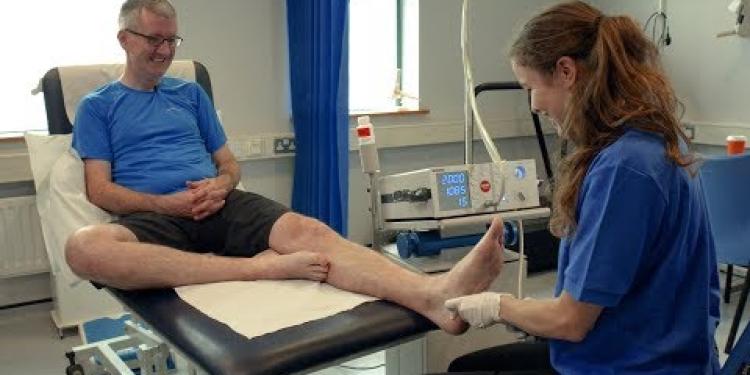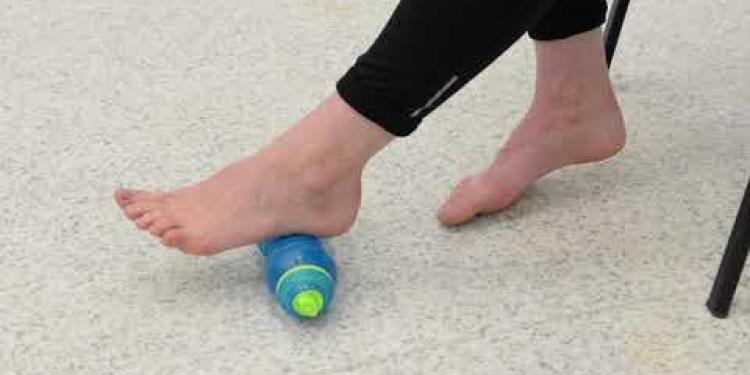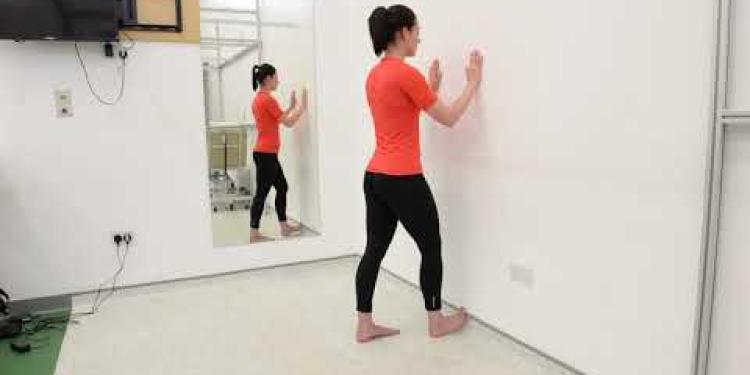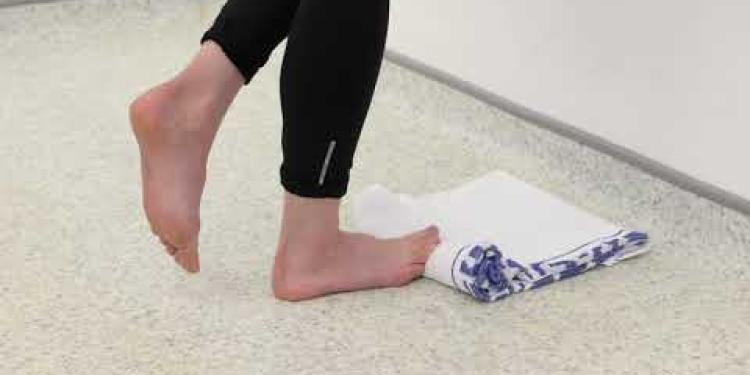Important Information On Using This Service
- Ergsy carefully checks the information in the videos we provide here.
- Videos shown by YouTube after a video has completed have NOT been reviewed by ERGSY.
- To view, click the arrow in the center of the video.
Using Subtitles and Closed Captions
- Most of the videos you find here will have subtitles and/or closed captions available.
- You may need to turn these on and choose your preferred language.
Turn Captions On or Off
- Go to the video you'd like to watch.
- If closed captions (CC) are available, settings will be visible on the bottom right of the video player.
- To turn on captions, click settings.
- To turn off captions, click settings again.
Find A Professional
More Videos On This Subjectdiagnosis
Heel Pain
Introduction to Heel Pain
Heel pain is a common problem that affects many people across the United Kingdom. It's often felt either behind or beneath the heel. Heel pain can be caused by a variety of factors ranging from simple wear and tear to more serious underlying conditions.
Common Causes of Heel Pain
One of the most common causes of heel pain is plantar fasciitis, an inflammation of the thick band of tissue that runs across the bottom of your foot. Other frequent causes include Achilles tendinitis, heel spurs, and bursitis. Conditions like arthritis, obesity, and ill-fitting shoes can also contribute to heel pain.
Symptoms to Look Out For
If you are experiencing heel pain, you may notice symptoms such as sharp pain under the heel, pain that worsens after rest but improves with activity, swelling, or even bruising. Pay attention to whether the pain is constant or comes and goes, as this can be helpful information for medical professionals.
Treatment Options
Treatment for heel pain typically begins with non-invasive approaches. Rest, ice application, and over-the-counter pain medications like ibuprofen can help manage pain. Special exercises to stretch the plantar fascia and Achilles tendon are often recommended. In some cases, orthotics or heel cups may provide relief. For persistent pain, physical therapy or even surgical options might be considered.
When to Seek Medical Advice
If your heel pain doesn't improve with simple home remedies or is severe enough to interfere with your daily activities, it's important to seek medical advice. A healthcare provider can offer a proper diagnosis and more targeted treatment options. Contact your GP or NHS 111 for guidance.
Preventing Heel Pain
Preventative measures to avoid heel pain include wearing supportive footwear, maintaining a healthy weight, and doing regular stretching exercises for your feet and legs. It's also advisable to avoid walking barefoot on hard surfaces for prolonged periods.
Frequently Asked Questions
What are common causes of heel pain?
Common causes of heel pain include plantar fasciitis, Achilles tendinitis, bursitis, and heel spurs.
How can I relieve heel pain at home?
You can relieve heel pain at home by resting your foot, applying ice, using over-the-counter pain relief, wearing supportive shoes, and performing stretching exercises.
When should I see a doctor for heel pain?
You should see a doctor if your heel pain is severe, persistent, or if you have redness, swelling, or difficulty walking.
What is plantar fasciitis?
Plantar fasciitis is inflammation of the plantar fascia, the thick band of tissue that runs across the bottom of your foot and connects your heel bone to your toes.
What are some effective treatments for plantar fasciitis?
Effective treatments for plantar fasciitis include rest, ice, stretching exercises, orthotics, and in some cases, physical therapy.
Can heel pain be prevented?
Heel pain can be prevented by wearing properly fitting shoes, avoiding walking barefoot on hard surfaces, maintaining a healthy weight, and doing regular stretching exercises.
What are heel spurs?
Heel spurs are bony growths that develop on the bottom of the heel bone and can cause heel pain.
How are heel spurs treated?
Heel spurs are treated with rest, ice, pain relief, orthotics, and sometimes physical therapy or surgery if other treatments fail.
What is Achilles tendinitis?
Achilles tendinitis is inflammation of the Achilles tendon, which connects the calf muscles to the heel bone.
What are common symptoms of Achilles tendinitis?
Common symptoms of Achilles tendinitis include pain and stiffness in the back of the heel, especially in the morning or after activity.
How can you treat Achilles tendinitis?
Treatment for Achilles tendinitis includes rest, ice, stretching exercises, and sometimes physical therapy or orthotics.
What is bursitis in the heel?
Bursitis in the heel is inflammation of the bursa, a small fluid-filled sac that reduces friction between tissues in the foot.
How is heel bursitis treated?
Heel bursitis can be treated with rest, ice, pain relief, and sometimes physical therapy or corticosteroid injections.
Can exercise cause heel pain?
Yes, exercise, especially high-impact activities like running and jumping, can cause heel pain if done excessively or without proper footwear.
What kind of shoes are best for preventing heel pain?
Shoes with good arch support, cushioning, and a proper fit are best for preventing heel pain.
Useful Links
Useful links from: Plantar fasciitis
- NHS - Plantar Fasciitis This page from the NHS provides an overview of plantar fasciitis including symptoms, causes, diagnosis, and treatment options.
- Versus Arthritis - Plantar Fasciitis Versus Arthritis offers detailed information on plantar fasciitis, including its symptoms, causes, and ways to manage the condition.
- Chartered Society of Physiotherapy - Plantar Fasciitis This resource from the Chartered Society of Physiotherapy provides evidence-based advice on managing plantar fasciitis at home and when to seek professional help.
- Health and Care Professions Council (HCPC) - Podiatry The HCPC provides insights on various podiatry conditions, including plantar fasciitis, and ways to access professional podiatric care in the UK.
Useful links from: Plantar Fascia Wall Stretch
- NHS - Foot Pain The NHS page provides comprehensive information about various causes of foot pain, including plantar fasciitis. Here, you can learn about symptoms, treatments, including exercises such as the plantar fascia wall stretch, along with other self-care tips.
- Versus Arthritis - Foot and Ankle Pain Versus Arthritis offers detailed information about pain in the feet and ankles, including conditions like plantar fasciitis. The site includes guides on managing the condition with stretching exercises and other treatments.
- NHS Inform - Plantar Fasciitis NHS Inform provides an informative guide on plantar fasciitis, covering symptoms, causes, treatments, and specific exercises like the plantar fascia wall stretch to help alleviate pain.
- Pain Concern - Plantar Fasciitis Pain Concern offers resources and information on plantar fasciitis, focusing on managing pain through treatments that include effective stretching exercises and other therapies.
Useful links from: Plantar Fascia Loading Exercise (High Load Exercise)
- NHS - Treatment for Plantar Fasciitis The NHS page on treatment for heel pain, including plantar fasciitis, provides a comprehensive overview of various treatment options including high-load exercises.
- Versus Arthritis - Plantar Fasciitis Versus Arthritis provides detailed information on plantar fasciitis, its causes, symptoms, and various treatment options including exercise recommendations.
- NHS Inform - Plantar Fasciitis NHS Inform offers information on the symptoms, causes, and treatments for plantar fasciitis. It includes advice on exercises that can help manage pain and support recovery.
- PhysioNet - Plantar Fasciitis Exercise Program PhysioNet provides an exercise program specifically designed for plantar fasciitis, including high-load exercises to help manage and alleviate symptoms.
More Videos On This Subjectdiagnosis
Have you found an error, or do you have a link or some information you would like to share? Please let us know using the form below.
- Ergsy carfully checks the information in the videos we provide here.
- Videos shown by Youtube after a video has completed, have NOT been reviewed by ERGSY.
- To view, click the arrow in centre of video.
- Most of the videos you find here will have subtitles and/or closed captions available.
- You may need to turn these on, and choose your preferred language.
- Go to the video you'd like to watch.
- If closed captions (CC) are available, settings will be visible on the bottom right of the video player.
- To turn on Captions, click settings .
- To turn off Captions, click settings again.



